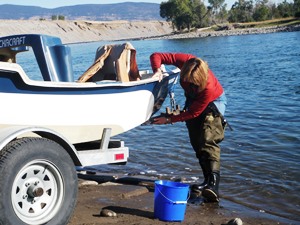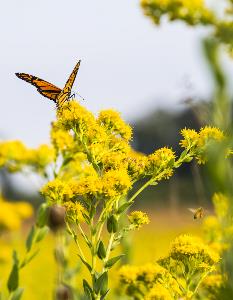Preventing Invasive Species
What Is an Invasive Species?
An invasive species is a plant, animal, or other living thing that evolves in one place, arrives in another place, and begins spreading in a way that harms native species and natural ecosystems.
Invasive species can hurt native species. For example, invasive snakes may decimate native bird populations. Or invasive plants can take up space where native plants should be, without providing food or shelter that native animals can recognize and use.
Invasive species can damage infrastructure. Zebra mussels can clog the intake pipes of water treatment plants and irrigation systems, making it more difficult and expensive to provide water for people and crops.
Invasive species can make outdoor recreation less fun. Eurasian watermilfoil can clog up shallow areas of lakes, making it impossible for boaters and swimmers to get through. Or we may find it difficult to enjoy a walk in the woods when all we see is a handful of invasive plant species, instead of the diverse understory that used to be there.
You can help. Once an invasive species gets a foothold, it can be almost impossible to eradicate. The best way to stop invasive species is to avoid introducing them to new places. Here are a few simple things you can do to keep out invaders.
Aquatic Invasive Species
How do aquatic invasive species spread? Many aquatic invasive species arrive in America by being accidentally transported here in the ballast water of oceangoing ships - and then they move from lake to lake by hitching rides with unsuspecting boaters and anglers. A whole population of invasive plants or mussels can start from a tiny fragment of leaf or a microscopic larva, so it's easy for these invaders to reach new water bodies by clinging to our gear.
What can you do? Prevention is the key to stopping aquatic invaders. Always thoroughly clean, drain, and dry all your equipment every time you come off the water. This way, plants and animals won't tag along to the next lake with you.
How do you clean, drain, and dry your equipment properly? It only takes a few minutes to make sure you aren't moving invasives between your favorite lakes. Here are the simple steps.
 Remove any visible plant matter, animals, mud, and dirt from your boat, trailer, boots, fishing tackle, water monitoring gear, and all equipment that has been in the water. Even plant fragments and dirt may contain tiny hitchhikers.
Remove any visible plant matter, animals, mud, and dirt from your boat, trailer, boots, fishing tackle, water monitoring gear, and all equipment that has been in the water. Even plant fragments and dirt may contain tiny hitchhikers.- Empty water from motors, jet drives, live wells, boat hulls, canoes and kayaks, and bait buckets. You must do this on site. If you wait until you get home to empty water, it can run into a storm drain and contaminate local waters.
- Clean your equipment – including your boat’s engine cooling system, live wells, and bilge – with hot tap water. If hot water is not available, spray equipment such as boats, motors, trailers, anchors, decoys, floats, and nets with high-pressure water.
- Equipment that cannot be exposed to hot water should be dipped in vinegar for 20 minutes or a one-percent saltwater solution for 24 hours. This table provides mixtures for the one-percent saltwater solution:
| Gallons of Water |
Cups of Salt |
| 5 |
2/3 |
| 10 |
1 1/4 |
| 25 |
3 |
| 50 |
6 1/4 |
| 100 |
12 2/3 |
- Allow boats and other equipment to dry for at least five days before using them in other waters.
- If your dog gets into the water, wash him or her with warm tap water as soon as possible, brushing the coat thoroughly to remove any clinging invasives.
- Do not release unused bait into the waters you are fishing, whether the bait was bought at a store or caught in local waters. Dump unused bait into a trash can.
It is important to follow these procedures every time you come off the water. Even if the waters look pristine, invasive species may be lurking under the surface – some so small that you cannot see them without a microscope.
Invasive Plants
How do invasive plants spread? Some invasive plants are moved to new areas accidentally. But more than half of the invasive plant species spreading across the United States today got here because the horticulture industry deliberately imported them. You've seen these plants - like burning bush, barberry, and English ivy - in nurseries and in your neighbors' yards. Every time we buy these exotic ornamentals and put them in our gardens, we are helping them spread.
 What can you do? Choose natives! With every passing year, native plants are becoming more popular and easier to find. Ask your local garden center to show you their selection of native plants. If they don't have any, ask them to stock some. Adopt these home-grown beauties instead of their foreign counterparts. Learn more about gardening with native plants.
What can you do? Choose natives! With every passing year, native plants are becoming more popular and easier to find. Ask your local garden center to show you their selection of native plants. If they don't have any, ask them to stock some. Adopt these home-grown beauties instead of their foreign counterparts. Learn more about gardening with native plants.
What else can you do? Invasive plants are very difficult to eradicate - but if everyone did their part, we could knock down the numbers of each invasive, and that makes an important difference. You can pitch in by learning what common invasive species look like and how to effectively eliminate a patch of them. Start with our short video about garlic mustard.
Invasive Species by Region
Learn which invaders to be on the lookout for in your area, and what you can do to slow their spread.
Or learn more about invasive species nationally from U.S. Fish and Wildlife or from the Army Corps of Engineers.